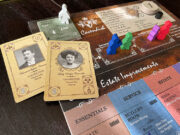 Every year for the last few years, a game has come out which fans claim is “like Scythe, but better.” As a huge fan of Scythe, I’m always equally skeptical and intrigued. Circadians: Chaos Order pits highly asymmetrical factions against each other as they compete for control of powerful relics, using the resources of the land as well as brute force.
Every year for the last few years, a game has come out which fans claim is “like Scythe, but better.” As a huge fan of Scythe, I’m always equally skeptical and intrigued. Circadians: Chaos Order pits highly asymmetrical factions against each other as they compete for control of powerful relics, using the resources of the land as well as brute force.
Circadians: Chaos Order plays from 2 to 5 players, and takes about 2 to 4 hours, depending on players count.
Gameplay Overview:
In Circadians Chaos Order, several asymmetric factions are competing to be the first to complete one of two win conditions. One win condition relates to simultaneously controlling several specific areas (those containing relics), of which the quantity decreases each round. The other possible win condition is specific to each unique faction.
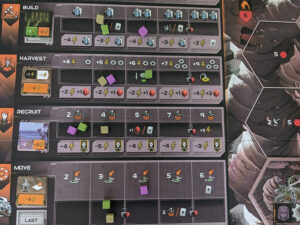
In each round, every player will “price” an action, setting the cost for other players to take that action and making it free for them. Once all players have priced an action, the action phases take place. Starting with the player who priced the action, each player will choose whether or not to complete the currently available action or pass. Action phases include discover, build, harvest, recruit, and move. During these phases, players will upgrade their action efficiency, construct bases and buildings on the board, harvest resources, recruit units and leaders, move units, and perform some auxiliary actions.
After all action phases are complete, combat takes place. Next, players gain income based on areas controlled and spots unlocked on their player boards. Finally, control is assessed for the relic of the current round. If all remaining relics are controlled, the controlling player wins the game. If not, the current round’s relic is given to the player who controls the area containing it.
The game also ends if one player completes their faction’s specific win condition, which is tracked on the main board.
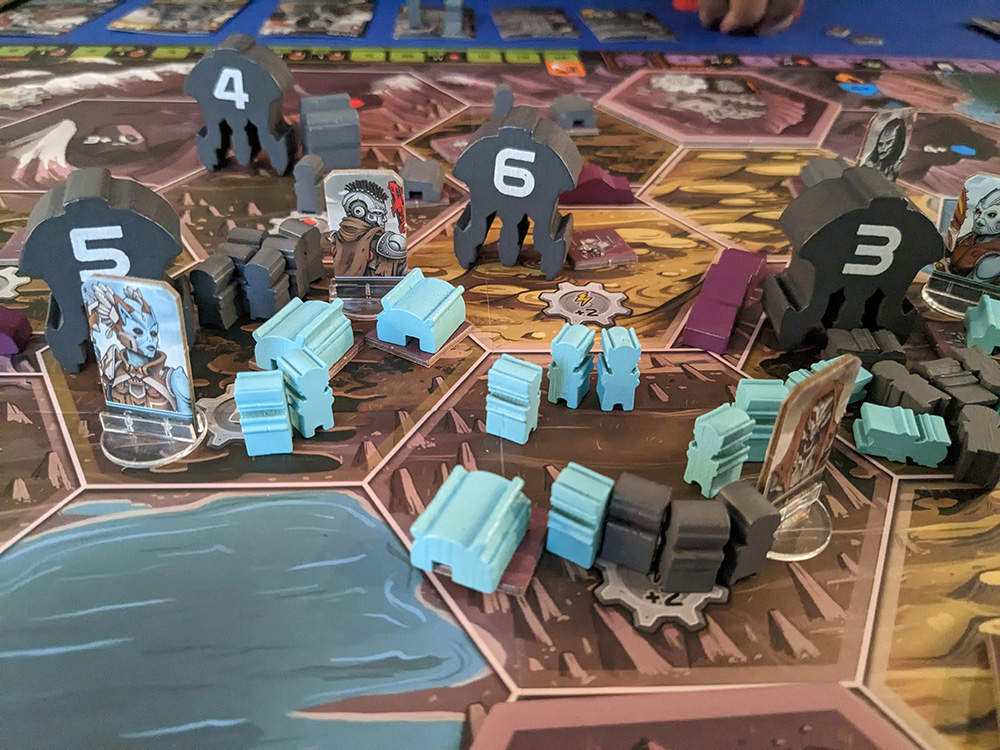
Game Experience:
This is an aggressive, combat-heavy game. If you liked the “knife fight in a phone booth” feel of Kemet, you’ll dig this. After the first round, if you’re not in a battle (or two or three) every round, you’re probably not doing well in the game. I like the combat system here. You’re only ever fighting one player at a time, but there are a lot of choices and minutia with the combat wheel and tactics cards. You are balancing strength (which wins battles), wounds (kills units), and shields (blocks wounds). You know the starting stats of both sides going into the battle based on troop size, leader presence, and any structures in the regions.
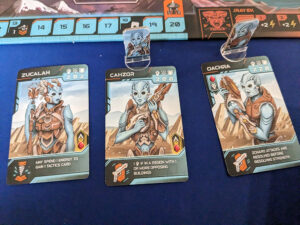
What you don’t know is what your opponent will set their wheel to and what card they may add, and your choices are unknown to your opponent. Plenty of double-think to go around. Strategic withdrawal is also at play here as one option on the combat wheel is to retreat. Even this creates more dynamism in the combat phase, since you can retreat units from one battle that you’re involved in right into another.
One of my favorite parts of the game is the action selection mechanism. Setting prices for actions feels fresh in this type of game, giving Circadians Chaos Order a bit more of an economic mechanism than others in the genre. It’s great that you not only get to choose what’s free for you, but you can choose between potentially pricing others out of specific actions or aiming to gain energy from them, since players have to pay you to complete the actions at the price you selected. If you time everything just right, you can afford to take every action you need and still have some energy left over for the next round.
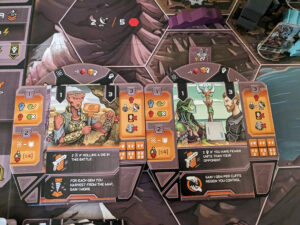
Upgrading your action efficiency is really straightforward using the discover action, yet always a tough decision. Most of the time, you are making an action cost less, provide more, or both. Choosing an extra recruitment point, movement point, or build point, could determine if you have a great round or a tragic one.
The game systems don’t get in the way of enacting your strategies. For instance, when you move from one area to another, you can take as many units as you’d like for just one movement point. When you build, any of your buildings or bases cost just one build point. Sometimes they’ll cost a gem as well, but those are easy enough to come by. Resources in this game are far from scarce. You have a pretty constant stream of income during various phases of the game. The challenge is not getting resources, but figuring out the best way to spend them. That’s the kind of gameplay that I prefer.
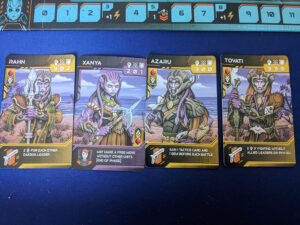
You’re building an engine in lots of different ways. Your board presence as well as which buildings you’ve built determine your income every round. How much you’ve researched determines which benefits you can get for each of the core actions, and we’re not talking about small increments. Take recruitment for example. At the start of the game, you’ll only be getting two recruitment points per round. If you research all the way up the recruitment track, you’ll instead be getting nine recruitment points per round. Finally, you have attribute cards and several leaders that can each be upgraded. There’s a whole lot to sink your teeth into here.
Let’s get into the asymmetry. There are six factions in the game. With each faction, you get to do some dope, game-breaking stuff. The Circadians have a drop ship, which allows them to carry units around the board and parachute them into regions, while also providing combat strength and harvesting abilities wherever it lands. The Zcharo can pay the bank instead of their opponents for priced actions. The Oxataya can bring two leaders into a battle (limit one for other factions). The AI has 30 fighter units in the game (10 more than the next highest) and can lay traps. I’m barely scratching the surface, but hopefully you get the idea. They clearly put a lot of thought into making each faction special.
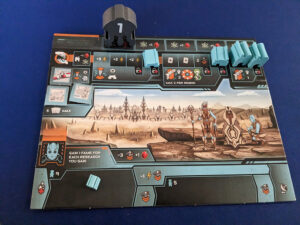
After all this gushing, I do have a negative point. For me, the game is a bit too long. It doesn’t feel slow and downtime is not a huge issue, but after three rounds, you may look up and see that 2 hours have passed, and there may be another two hours to go. Don’t get me wrong, I enjoy the ride, but it is a commitment. I did not even bother trying the game at 5 players, and I’m not sure I’ll ever have the time or willing players to commit to that. I know a lot of heavy gamers will roll their eyes at this criticism, but it’s important to me.
Final Thoughts:
Going back to my intro, I don’t think Circadians: Chaos Order is a Scythe substitute. However, I think this game could be my Root. Each faction is deserving of multiple plays to learn and then master, and they’ll require different strategies based on player count and what other factions are in play. It is a little long to get played with a lot of regularity, but I can see it coming out for a few weeks straight, allowing me to dive deep into a specific faction over several games. I’m looking forward to digging into this even more.
Final Score: 4.5 Stars. Highly asymmetric and aggressive area control game with robust engine building and a great action selection mechanism.
 Hits:
Hits:
• Every faction has game-breaking abilities that are a joy to explore
• Combat happens early and often, but resolves quickly
• Action selection mechanism has a neat economic component to it
• Strong engine building with lots of ways to customize as you play
Misses:
• Takes a long time to play



